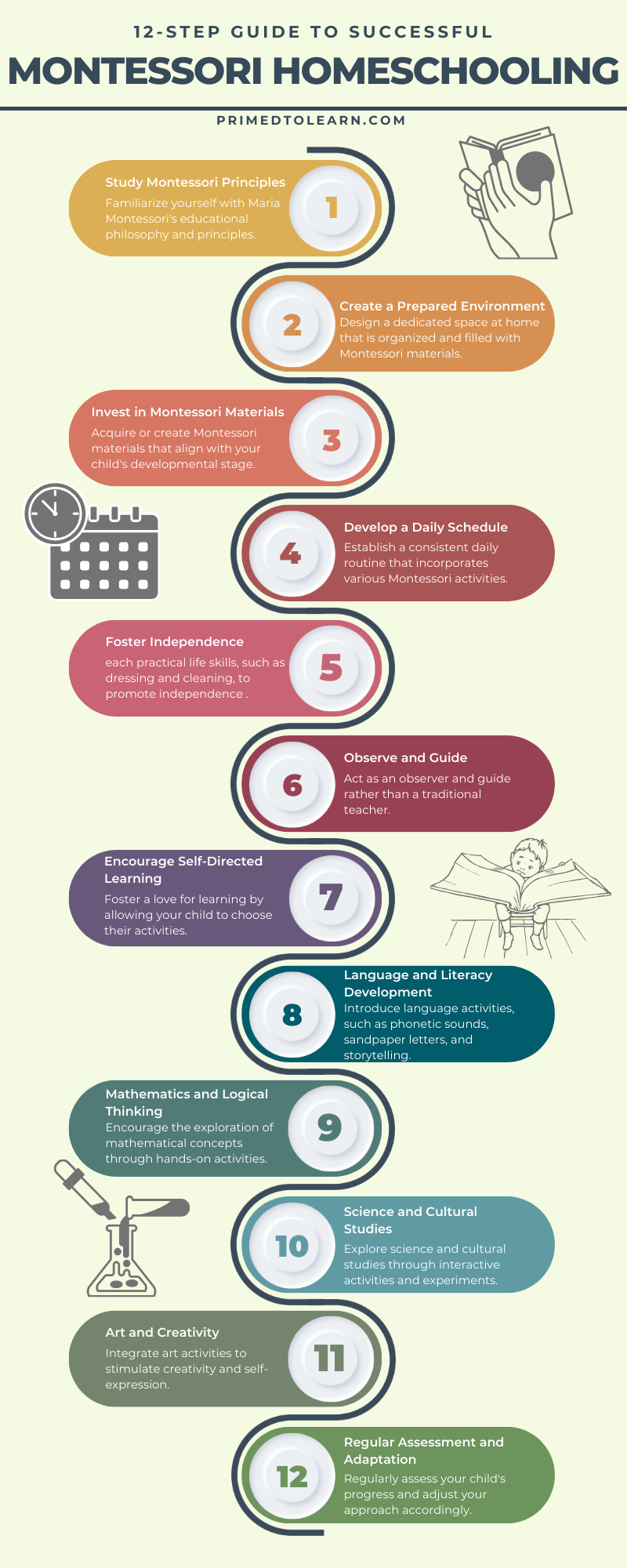If you’re new to the concept, the Montessori homeschooling method is an educational approach based on self-directed activity, hands-on learning, and collaborative play. Developed by Italian physician and educator Maria Montessori, it has been transforming the way children learn and grow for over a century.
In a Montessori homeschool setting, children are free to make creative choices in their learning, while the environment and the materials encourage development at their own pace.
We’ll take a look at the principles and practices of the Montessori homeschooling method. And equip you with the knowledge and understanding to effectively apply it in your homeschooling journey. Get ready to transform your child’s learning experience!
The Basics of Montessori Education
History and origins of the Montessori method
The Montessori Method of education was developed in the early 20th century by Dr. Maria Montessori. Dr. Montessori, an Italian physician, and educator, was one of the first women to graduate from the University of Rome Medical School. Her interest in education sparked when she worked with intellectually and developmentally disabled children. Observing these children, she developed a range of learning materials and a fresh educational approach that encouraged self-initiated learning within a carefully prepared environment.
Her method was first implemented in the “Casa dei Bambini” or “Children’s House” in Rome, Italy, in 1907. The success of this first school, which served children from disadvantaged backgrounds, quickly garnered international attention. Dr. Montessori’s methods, focused on fostering independence, respect for a child’s natural psychological development, and the belief that children are naturally eager learners, quickly spread across the globe. Today, the Montessori Method of homeschooling is used in an estimated 20,000 schools worldwide, serving children from birth to eighteen years old.
Core principles and philosophy
The Montessori Method is anchored on several core principles that differentiate it from traditional education approaches.
Child-Centered Environment
At the heart of the Montessori philosophy is the belief that learning should be an enjoyable, self-motivated process. As such, the method emphasizes a child-centered environment where children are empowered to make choices about their learning based on their interests and developmental needs.
Hands-On Learning
It also advocates for hands-on, concrete learning as opposed to abstract teaching. The method brings in a multitude of sensory-rich learning materials that students can manipulate and explore, thereby fostering a deeper understanding of concepts.
Individual Learning Pace
The Montessori method also respects the individual learning pace of each child. Children are allowed to learn at their own speed, enabling them to build competency and confidence without the pressure of keeping up with a uniform class pace.
Holistic Development
Dr. Montessori believed in the education of the whole child – not just the mind but also the body, emotions, and spirit. Thus, the Montessori method seeks to nurture a child’s physical, social, emotional, and cognitive growth.
These principles come together to create a unique learning environment that encourages curiosity, creativity, and critical thinking, paving the way for lifelong learners.
Montessori Materials and Prepared Environment
Montessori materials play a pivotal role in the Montessori homeschooling method. These are specifically designed to stimulate the child’s natural curiosity and desire for exploration. Each material serves a distinct purpose, aimed at developing a particular skill or fulfilling a specific learning outcome. For instance, the Pink Tower promotes spatial awareness and fine motor skills, while the Sandpaper Letters lay the groundwork for reading and writing by combining tactile and visual experiences.
The ‘Prepared Environment‘ is another cornerstone of Montessori homeschooling. This refers to a thoughtfully organized, child-friendly space that facilitates independent learning. The environment is carefully curated with furniture suitable to the child’s size, Montessori materials arranged methodically, and learning areas designated for different subjects. The aim is to create a space that encourages exploration, freedom of movement, and choice, thereby fostering an atmosphere of self-directed learning and growth.
Role of the Teacher in Montessori Education
In the Montessori homeschooling method, the teacher takes on the role of a guide rather than a traditional instructor. The teacher observes the child closely, understanding their interests, strengths, and areas of growth. Based on these observations, they prepare the learning environment and present materials that align with the child’s development and curiosity.
This approach encourages the child to engage with activities that resonate with their own intrinsic motivations. The teacher is also responsible for creating a safe, respectful, and supportive learning atmosphere. They model behaviors such as patience, empathy, and active listening, setting the tone for positive and respectful interactions within the homeschooling setup.
The teacher in Montessori education is a facilitator who inspires self-directed learning and cultivates an environment conducive to the child’s holistic development.

The Montessori Homeschooling Environment
Creating a Montessori-Inspired Homeschooling Space
Creating a Montessori-inspired homeschooling space involves meticulous planning and thoughtful execution. This space is designed to be child-centric, prioritizing accessibility and independence.
Furniture should be child-sized to allow for easy access, and materials should be displayed on low, open shelves that a child can manage independently. The layout of the space should be intuitive and organized by subject area, making it easy for children to find, use, and return materials.
The environment should be inviting, calm, and clutter-free to promote focus and concentration. Natural light, plenty of green indoor plants, and calm, neutral colors can enhance the sense of tranquility. Each object within the space should serve a purpose and facilitate a particular form of learning or skill development.
By creating such an environment, you can foster an atmosphere of curiosity, self-guided education, and respect for the learning process.
The Importance of Child-Centered Design
The importance of child-centered design in the Montessori homeschooling method cannot be overstated. This approach respects the individuality of each child and emphasizes on their unique interests, abilities, and learning pace. A child-centered design encourages children to actively participate in their own learning process, cultivating their intrinsic motivation to explore and learn.
In addition, it nurtures a sense of independence and self-confidence as children make decisions about what to learn and how to go about it. This direct involvement in their own learning process fosters critical thinking, problem-solving, and decision-making skills, key competencies that prepare them for lifelong learning. Hence, in a Montessori homeschooling setup, a child-centered design is not just an element of physical space but a philosophy that permeates every aspect of the educational experience.
Adapting the Montessori Materials for Home Use
Adapting the Montessori materials for home use is a practical approach to Montessori homeschooling. These materials, originally designed for a classroom setting, can be conveniently modified or replaced with similar items readily available at home.
For instance, instead of investing in a complete Montessori math kit, you can use everyday objects like beans or pasta for counting exercises. Similarly, tactile letters for language learning can be replaced with homemade sandpaper letters.
The primary goal is to adhere to the Montessori principle of providing hands-on, sensory-rich learning experiences. Remember, the essence of Montessori education lies not in the specific materials used, but in the child’s active engagement and interaction with the learning environment.
When adapting Montessori materials for home use, creativity, resourcefulness, and a deep understanding of the Montessori philosophy are key.
Organizing a Daily Schedule
Organizing a daily schedule in a Montessori homeschooling environment is a balance between structure and flexibility. It’s crucial to establish a rhythm that provides consistency, yet allows for spontaneous, child-led learning opportunities.
A well-structured day might start with a calm morning routine, followed by focused learning time. This is when you can incorporate Montessori activities that encourage hands-on learning. Following this, a break for lunch and free play provides a natural intermission.
In the afternoon, children can engage in creative pursuits, outdoor exploration, or quiet reading time—activities that fortify the Montessori principle of learning through exploration and independence. Finally, the day can wind down with family time, dinner, and a restful bedtime routine.
While structure is beneficial, it’s equally important to be flexible and attuned to your child’s individual needs and rhythms. The goal is not to rigidly follow a timetable, but to create an environment that facilitates natural, joyful learning.
Montessori Curriculum for Homeschooling
Overview of Montessori curriculum areas
The Montessori curriculum is divided into several key areas, each designed to foster different aspects of a child’s growth and development.
- Practical Life: This area focuses on activities that help children develop skills for daily living, such as dressing, cooking, and cleaning. The aim is to foster independence, coordination, and concentration.
- Sensorial: Sensorial activities engage the child’s senses and help them understand and classify sensory impressions in relation to length, width, temperature, mass, color, pitch, etc.
- Mathematics: In the Montessori method, mathematical concepts are introduced through concrete, hands-on materials, gradually leading children towards abstract thinking.
- Language Arts: This area emphasizes the development of oral language, written expression, reading skills and grammar through phonetic awareness and storytelling.
- Cultural Studies: This includes geography, history, and life sciences, encouraging children to explore their world and gain an understanding of other cultures.
- Art, Music, and Movement: These areas allow children to express themselves creatively and develop an appreciation for the arts.
The idea is to create a cohesive, interconnected learning experience where each area supports and enriches the others. In the Montessori homeschooling method, it’s all about nurturing a well-rounded, holistic learning environment.
Language and Literacy Development
The Montessori approach to language and literacy development is built upon a child’s natural curiosity and desire for communication. Early on, children are introduced to phonetic sounds, which lays the foundation for subsequent reading and writing abilities.
The process begins with oral language development which includes storytelling, conversations, and vocabulary enrichment. The child is then gradually introduced to letters and sounds in a fun, engaging way through materials like sandpaper letters. This tactile approach allows children to feel the shape of the letter while also hearing its sound, enhancing their phonetic awareness.
Next, the child begins to blend sounds to form words, a critical step in developing reading skills. Simultaneously, children are introduced to the concept of writing through activities such as tracing letters. They start to write words, and then sentences, progressing naturally from their reading ability.
Grammar is incorporated in a hands-on and visual way, often using symbols and storytelling to make the understanding of complex concepts easier. For example, verbs might be introduced as “action words” and illustrated with a running figure.
Lastly, reading is seen not just as a skill but as a gateway to explore and learn about the world, which ties nicely into the Cultural Studies area of the Montessori curriculum. Thus, the Montessori method for language and literacy development ensures a comprehensive, well-rounded approach.
Mathematics and Logical Thinking
In the Montessori homeschooling method, Mathematics and Logical thinking are introduced in a concrete, hands-on manner, gradually transitioning to abstract concepts. Children start by learning number sense and numerals using manipulative materials such as number rods and spindles. They explore concepts of quantity before they are introduced to the corresponding symbols, this hands-on approach fostering a deeper understanding.
Gradually, children are introduced to the decimal system and the four operations – addition, subtraction, multiplication, and division. They engage with materials like golden beads and stamp games, which provide a visual and tactile representation of these mathematical operations.
Logical thinking is interlaced within these mathematical lessons. Children are encouraged to solve problems, understand patterns, and make connections. Exercises such as the tower of cubes promote spatial reasoning and problem-solving skills.
Thus, the Montessori approach to Mathematics and logical thinking provides a strong foundation for mathematical understanding and cognitive development, aiming to nurture a lifelong love for learning and problem-solving in children.
Science and Nature Exploration
The Montessori curriculum places significant emphasis on Science and nature exploration, fostering curiosity, inquisitiveness, and love for the natural world. In the Montessori homeschooling method, Science is experienced, rather than just learned. Children observe, question, experiment and analyze, developing critical thinking skills along the way. The curriculum is designed to provide a broad understanding of biology, chemistry, physics, geography, and astronomy – all integrated within a framework of natural exploration.
Children learn about plants, animals, and humans in biology, the earth’s waters, lands, and climate in geography, and basic scientific principles in physics. Hands-on experiments, outdoor expeditions, and practical applications are common teaching methods, enhancing the child’s understanding and enjoyment of science.
In nature exploration, children are encouraged to interact with their environment, to observe and question what they see, and to nurture a deep respect for the world around them. Activities such as gardening, identifying plants and animals, tracking weather, and exploring different habitats are incorporated into the Montessori homeschooling method. This child-led, experiential approach to Science and nature exploration creates well-rounded, scientifically literate children who appreciate and understand the world they live in.
Cultural Studies and Geography
Cultural Studies and Geography play an integral part in the Montessori homeschooling method. This area of study is designed to nurture an understanding and appreciation for diverse cultures, societies, and geographical features around the world. It encourages children to explore the customs, traditions, languages, and living conditions of people in different regions, fostering empathy, tolerance, and a global perspective.
Geographical studies in Montessori curriculum offer hands-on experiences with physical maps, globes, and puzzles, and introduce children to the concepts of continents, countries, states, and cities. By studying the earth’s physical geography, children develop a profound understanding of different landscapes, climates, and ecosystems. Furthermore, they examine human geography to understand how people and their environments interact.
The Montessori homeschooling method’s approach to Cultural Studies and Geography is comprehensive and child-centered, aiming to cultivate knowledgeable, respectful, and globally aware individuals.
Art and Creativity
Art and creativity in the Montessori homeschooling method are not confined to specific lessons or activities. Instead, they are integral components of each child’s day, intertwined with other areas of learning, and encouraged in all forms of self-expression. This approach to art education allows children to explore different mediums, styles, and techniques at their own pace, encouraging individuality and creative thinking.
Montessori art activities often involve practical skills such as cutting, pasting, and hand-eye coordination, enhancing the child’s fine motor abilities. Exposure to art from different cultures and periods fosters an appreciation of humanity’s diverse artistic heritage. Ultimately, by promoting creativity, artistic exploration, and self-expression, the Montessori homeschooling method cultivates not just a love of art, but also the confidence to create and innovate.
Practical Life Skills and Independence
In the Montessori homeschooling method, Practical Life Skills and Independence hold a central position. This curriculum area features activities that foster autonomy and self-reliance, instilling in children the confidence to contribute meaningfully within their own environments.
Tasks such as dressing, preparing food, cleaning, and setting the table are viewed not as chores, but as valuable learning opportunities. These activities not only improve fine motor skills and hand-eye coordination, but they also enhance the children’s problem-solving abilities and develop their sense of responsibility.
By encouraging children to participate in everyday tasks, the Montessori homeschooling method helps them to understand their capability and fosters a sense of pride in their work. This respect for the child’s ability to learn, grow, and contribute is a cornerstone of the Montessori philosophy, promoting the development of capable, confident, and independent individuals.
Homeschooling with the Montessori Method
The Role of the Parent as a Guide
In the Montessori homeschooling method, the parent adopts the role of a guide rather than a traditional authoritative teacher. As a guide, the parent observes the child’s interests, needs and progression, and provides materials and activities that foster self-directed learning.
The parent’s role is to create a prepared environment, conducive for exploration, discovery, and learning. This environment is filled with age-appropriate resources that stimulate curiosity and engage the child in meaningful, hands-on learning experiences. The parent-guide respects the child’s individuality, allowing them to learn at their own pace, encouraging self-correction and fostering independence.
This guiding role is pivotal in the Montessori homeschooling method as it cultivates a love for lifelong learning, fosters critical thinking, and promotes an inherent respect for the child’s capability.
Encouraging self-directed learning
Self-directed learning is a key component of the Montessori homeschooling method. This approach empowers children to take ownership of their education, fostering curiosity and instilling a love for learning.
Children are encouraged to explore subjects that interest them, choose their activities, and set their own learning pace. This approach not only develops the child’s decision-making skills, but also promotes creativity, independence, and self-confidence. As the child progresses, they learn to rely less on the parent-guide and become more self-reliant, thus preparing them for real-world challenges.
The role of the parent-guide in self-directed learning is chiefly to provide a nurturing, engaging environment, filled with enriching resources that stimulate curiosity and allow children to explore, discover, and learn according to their interests and capabilities.
Observing and Assessing Your Child’s Progress
Observing and assessing your child’s progress is an integral part of the Montessori homeschooling method. Unlike traditional grading systems, assessment in Montessori is less about quantifying and more about understanding the child’s learning journey.
As a parent-guide, your role involves observing your child’s interactions, engagement with materials, and participation in activities. Take note of their interests, strengths, areas for growth, and pace of learning. These observations should be non-judgmental and aim to understand the child’s unique learning style.
The goal is not to compare your child with others, but to nurture their individual growth and development. Tracking and documenting this progress can be done through journals, portfolios, or checklists, providing tangible evidence of their learning journey.
This holistic and individualized assessment approach strengthens the learning experience and promotes the development of well-rounded, confident learners.
Fostering a Love of Learning and Exploration
The Montessori homeschooling method places significant emphasis on fostering a love of learning and exploration. Through self-directed activities, children are encouraged to explore and learn at their own pace, promoting curiosity and a deep-seated passion for knowledge.
This love for learning is nurtured by providing a diverse range of materials and resources that cater to the child’s interests, fueling their enthusiasm and motivating them to acquire new skills. Exploration is also fostered by creating an environment that values questions, encourages experimentation, and celebrates discovery. Instead of being passive recipients of information, children become active investigators, fully engaged in their learning process.
This approach ensures that learning is not just about passing exams or ticking boxes, but a lifelong journey of curiosity, exploration, and growth.
Challenges and Solutions
While the Montessori homeschooling method offers numerous benefits, it can also present some challenges. Here are some common obstacles and practical tips to overcome them.
Time Commitment
Montessori homeschooling requires a significant time commitment from parents. This can be overwhelming, especially for those juggling work and other responsibilities.
Overcoming the Challenge: Create a consistent schedule that works for your family. You can incorporate learning into everyday activities. Remember, it’s about the quality of time spent, not the quantity.
Lack of Socialization
Homeschooling can limit children’s social interactions, impacting their social development.
Overcoming the Challenge: Arrange playdates, participate in community activities, or join local homeschooling groups to provide your child with opportunities for social interaction.
Material Costs
Montessori materials can be expensive, and purchasing a full set may not be financially feasible for many families.
Overcoming the Challenge: Homemade or alternative materials can be just as effective. Use online resources for DIY Montessori materials or swap resources with other homeschooling families.
Lack of Support
Homeschooling can sometimes be a lonely journey without the support system provided by traditional schools.
Overcoming the Challenge: Connect with other homeschooling parents for support, ideas, and encouragement. Online homeschooling forums and local groups can be a great resource.
Every homeschooling journey is unique, and challenges are part of the process. The key is to remain flexible, seek support when needed, and always keep the child’s interests and needs at the forefront.
Final Thoughts on the Montessori Homeschooling Method
The Montessori homeschooling method is an effective and enriching approach to education that prioritizes child-led learning. It empowers children by allowing them to direct their own learning journey, fostering a love for knowledge, self-confidence, and independence.
This method encourages hands-on, practical learning which can be seamlessly integrated into everyday activities at home. While the initial setup and costs can seem daunting, the flexibility of this method allows for the use of alternative and homemade Montessori materials.
By implementing the Montessori homeschooling method, parents can provide their children with a personalized and holistic education experience, focusing on their individual interests and pace of learning. It’s a journey that may pose challenges, but the rewards—in the form of your child’s growth and development—are indeed invaluable.



